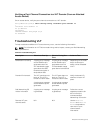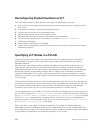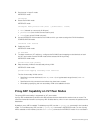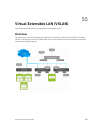3. Set the port in Layer 2 mode.
INTERFACE mode
switchport
4. Select the PVLAN mode.
INTERFACE mode
switchport mode private-vlan {host | promiscuous | trunk}
• host (isolated or community VLAN port)
• promiscuous (intra-VLAN communication port)
• trunk (inter-switch PVLAN hub port)
5. Access INTERFACE VLAN mode for the VLAN to which you want to assign the PVLAN interfaces.
CONFIGURATION mode
interface vlan vlan-id
6. Enable the VLAN.
INTERFACE VLAN mode
no shutdown
7. To obtain maximum VLT resiliency, configure the PVLAN IDs and mappings to be identical on both
the VLT peer nodes. Set the PVLAN mode of the selected VLAN to primary.
INTERFACE VLAN mode
private-vlan mode primary
8. Map secondary VLANs to the selected primary VLAN.
INTERFACE VLAN mode
private-vlan mapping secondary-vlan vlan-list
The list of secondary VLANs can be:
• Specified in comma-delimited (VLAN-ID,VLAN-ID) or hyphenated-range format (VLAN-ID-
VLAN-ID
).
• Specified with this command even before they have been created.
• Amended by specifying the new secondary VLAN to be added to the list.
Proxy ARP Capability on VLT Peer Nodes
The proxy ARP functionality is supported on VLT peer nodes.
A proxy ARP-enabled device answers the ARP requests that are destined for another host or router. The
local host forwards the traffic to the proxy ARP-enabled device, which in turn transmits the packets to the
destination.
By default, proxy ARP is enabled. To disable proxy ARP, use the no proxy-arp command in the interface
mode. To re-enable proxy ARP, use the ip proxy-arp command in INTERFACE mode. To view if proxy
ARP is enabled on the interface, use the show config command in INTERFACE mode. If it is not listed in
990
Virtual Link Trunking (VLT)


















